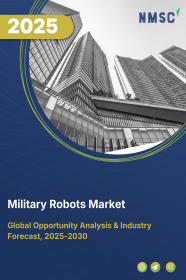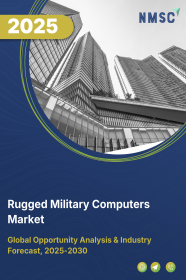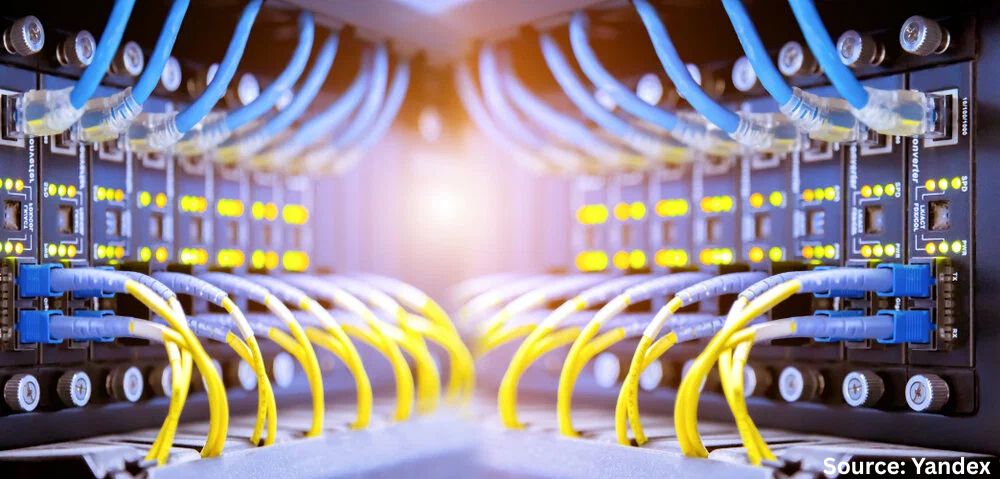
Military Robots Market by Type (Land-Based Robots, and Others), by Mode of Deployment (Ground Deployment, and Others), by Mode of Operation (Land Robots, and Others), by Mobility (Wheeled, Tracked, and Others), by Propulsion Type (Electric, Mechanical, and Hybrid), by Range (Land Robots (Upto 1 KM, 1 KM to 5 KM), and Others), by Application (Intelligence, Surveillance, and Others), and by End-Users (Army, and Others) –Global Opportunity Analysis and Industry Forecast 2025-2030
US Tariff Impact on Military Robots Market
Trump Tariffs Are Reshaping Global Business
Military Robots Industry Overview
The global Military Robots Market size was valued at USD 29.06 billion in 2024 and is predicted to reach USD 31.54 billion by the end of 2025. The industry is predicted to reach USD 48.08 billion by 2030 with a CAGR of 8.8% from 2025-2030.
The market is growing due to the need to reduce human casualties, enhance combat capabilities, and address evolving global threats. Robots, such as unmanned ground and aerial vehicles, help protect soldiers and improve operational efficiency.
However, the market faces challenges like operating in harsh conditions and developing advanced AI systems. A key opportunity in the military robotics industry is advancing human-machine teaming technologies to enhance operational effectiveness through collaboration between soldiers and robots.
The Growing Need to Reduce Human Casualties Fuels the Market Growth
A significant driving force behind the burgeoning military robots market is the fundamental need to minimize casualties and protect military personnel. By deploying robots in dangerous and high-risk scenarios, armed forces can reduce the exposure of soldiers to direct combat, hazardous material handling, and explosive ordnance disposal.
For instance, robots are increasingly being utilized for mine countermeasures, thereby saving countless lives. This focus on force protection is a key element propelling the demand for unmanned ground vehicles (UGVs), unmanned aerial vehicles (UAVs) or drones, and other robotic systems, contributing to the overall market growth and expanding the industry size.
The Rising Demand for Advanced Combat Capabilities Fuels the Market Expansion
The integration of military robots significantly enhances the operational effectiveness of armed forces. These robotic systems can operate in diverse and challenging environments, often exceeding human limitations in terms of endurance, speed, and precision.
Equipped with advanced sensors, AI-powered capabilities, and communication technologies, robots can perform tasks such as reconnaissance, surveillance, target acquisition, and even direct combat with greater efficiency. The U.S. Army, for example, is actively experimenting with human-machine teaming to leverage the strengths of both soldiers and robots in future warfare scenarios. This increased efficiency and capability offered by military robotics act as a major market driver, fueling investment and innovation within the sector.
The Need to Address Evolving Threats Drives the Military Robots Market Growth
The dynamic and increasingly complex global security landscape necessitates the adoption of advanced technological solutions, making it a crucial driver for the military robots market demand. From counter-terrorism operations to large-scale conflicts, the nature of warfare is evolving rapidly. Military robots, including autonomous systems and loitering munitions, offer a means to effectively address these evolving threats.
The conflict in Ukraine has highlighted the growing importance of drones and robotic systems on the battlefield. Nations are in a race to deploy robots, recognizing their strategic value in modern defense strategies. This imperative to stay ahead of emerging threats and maintain a strategic advantage is a significant factor driving the growth potential of the military robotics industry.
Technological and Environmental Limitations Restrain the Market Growth
The market still faces technological limitations and challenges related to reliability in real-world military environments. Robots need to operate effectively in harsh weather conditions, navigate complex terrains, and withstand electronic warfare and cyber threats.
Ensuring robust communication and seamless integration with existing military infrastructure also presents significant technical hurdles. Furthermore, the development of sophisticated AI algorithms that can accurately interpret battlefield situations and make sound judgments remains an ongoing challenge. These technological and environmental constraints can slow down the deployment and wider adoption of advanced military robotics, impacting the overall market size in the short to medium term.
Advancement of Human-Machine Teaming Technologies Presents Key Market Opportunities
A significant opportunity for players in the military robot industry lies in the development and advancement of human-machine teaming (HMT) technologies. This involves creating systems where soldiers and robots work together synergistically, leveraging the strengths of both. Examples include soldiers controlling swarms of drones for reconnaissance or robots providing autonomous logistical support.
For instance, The Indian army is exploring AI-assisted military operations through HMT. A notable development in this space occurred in August 2024, when Zen Technologies introduced the Prahasta Robot Dog, an armed quadruped robot equipped with LiDAR and reinforcement learning capabilities. It is designed to enhance soldier navigation and threat assessment during counter-insurgency operations.
By focusing on creating intuitive interfaces, secure communication links, and intelligent autonomous capabilities that complement human decision-making, companies tap into a growing demand for solutions that enhance operational effectiveness without fully removing humans from the loop. This area holds immense growth potential and represents a key direction for innovation within the military robotics market.
Market Segmentation and Scope of the Study
The military robots market report is segmented on the basis of type, mode of deployment, mode of operation, mobility, propulsion type, range, application, end user, and region. On the basis of type, the market is categorized into land-based robots, air-based robots, and marine-based robots. The land-based robots segment includes unmanned ground vehicles (UGVs), combat robots, explosive ordnance disposal (EOD) robots, surveillance & reconnaissance robots, and logistics & support robots. The air-based robots segment is further segmented into unmanned aerial vehicles (UAVs), including fixed-wing UAVs, rotary-wing UAVs, and hybrid UAVs. The marine-based robots segment includes unmanned surface vehicles (USVs), autonomous underwater vehicles (AUVs), and remotely operated vehicles (ROVs). On the basis of mode of deployment, the market is segmented into land robots, marine robots, and air robots. Land robots is further divided into round deployment, hand-tossed deployment, air deployment. Marine robots are further divided into surface deployment, tube-launched, and air deployment. Air robots are further divided into runway takeoff, catapult-launched, hand-launched, and air deployment. On the basis of mode of operation, the market is segmented into land robots, marine robots, and air robots. Land Robots are further divided into teleoperated and autonomous. Marine robots include remotely operated, autonomous. Air robots include remotely operated and autonomous.On the basis of mobility, the market is classified into wheeled, tracked, legged, and hybrid. On the basis of propulsion type, the market is segmented into electric, mechanical, and hybrid. On the basis of range, land robots, marine robots, air robots. Land robots are segmented into up to 1 km, 1 km to 5 km, and more than 5 km. Marine robots are segmented into up to 3 nautical miles, 3 to 5 nautical miles and more than 5 nautical miles. Air robots are segmented into up to 150 km and more than 150 km.On the basis of application, the market is segmented into intelligence, surveillance, and reconnaissance (ISR), combat support, search and rescue, explosive ordnance disposal (EOD), border patrol, logistics and supply delivery, target acquisition, chemical, biological, radiological, and nuclear (CBRN) detection, training and simulation, and others. On the basis of end user, the market is segmented into the army, navy, air force, and others. Regional breakdown and analysis of each of the aforesaid segments include regions comprising North America, Europe, Asia-Pacific, and RoW.
Geographical Analysis
North America plays a pivotal role in the global military robotics industry, driven primarily by the United States Army's forward-looking approach to human-machine teaming and the integration of advanced robotic systems into future combat strategies. The U.S. military’s active experimentation with autonomous platforms, AI-powered decision-making tools, and unmanned ground and aerial systems has significantly influenced the region’s market dominance. This strategic focus not only enhances operational capabilities but also contributes substantially to shaping global market trends, reinforcing North America’s leadership position in the evolving defense landscape.
In Europe, the momentum is steadily building as countries increasingly invest in domestic defense technologies. Companies like KNDS, formed through the merger of France’s Nexter Systems and Germany’s Krauss-Maffei Wegmann, are emerging as key players in the development of military robotics. Their focus on producing advanced, interoperable unmanned systems reflects a broader regional commitment to enhancing military readiness and strategic autonomy. Europe’s growing investment in indigenous robotics capabilities highlights its ambition to play a more prominent role in the global defense technology ecosystem.
The Asia-Pacific region is witnessing accelerated growth in military robotics, with China at the forefront. China’s large-scale deployment of interconnected unmanned systems across land, air, and sea domains showcases its commitment to achieving technological superiority in modern warfare. At the same time, India is making significant strides through the Indian Army’s exploration of robotic mules for logistics and AI-assisted operations through human-machine teaming. These developments highlight the region’s rapid adoption of robotics and its strategic shift toward technology-driven defense solutions.
In rest of the world, the operational relevance of military robotics is being underscored by ongoing conflicts, particularly the war in Ukraine. The use of unmanned aerial vehicles (UAVs) and other robotic platforms has demonstrated their effectiveness in reconnaissance, surveillance, and combat roles. The conflict has brought global attention to the real-time impact of robotics on modern warfare, prompting increased investment and strategic interest in similar technologies across various nations.
Together, these regional dynamics illustrate a global movement toward the integration of unmanned and intelligent systems in military operations. The diverse approaches ranging from North America’s technological leadership and Europe’s industrial development to Asia-Pacific’s rapid advancements and the real-world deployment seen in Ukraine are collectively driving the expansion of the military robotics industry. These developments are shaping the future structure and scale of defense capabilities worldwide, marking a significant evolution in how modern military forces are equipped and deployed.
Strategic Innovations Adopted by Key Players
Key players in the global military robots industry are strategically focusing on advancing unmanned systems through innovative developments and collaborations to capture a larger market share of the growing market size. For instance, the U.S. Army is actively experimenting with human-machine teaming (HMT), integrating robots into soldier operations, supported by companies like Teledyne FLIR, which launched the SUGV 325 in March 2025.
This modular unmanned ground vehicle (UGV), weighing under 20 pounds, enhances portability and features CBRN sensors, manipulators, and autonomous navigation for reconnaissance and threat detection, exemplifying the push for seamless HMT. KNDS is positioning itself as a primary provider of military robots, focusing on advanced tracked and wheeled systems. Significant activity is also evident with China exploring large-scale interconnected robot deployments using 5G technology, and the Indian Army adopting robotic mules while advancing AI-assisted operations through HMT.
Companies are developing robots with enhanced communication skills for effective collaboration with human soldiers. However, these industry players face challenges such as navigating ethical considerations surrounding autonomous weapons and overcoming technological limitations to ensure robot reliability in complex battlefield environments. Looking ahead, the continued development and refinement of HMT technologies, alongside innovations like Teledyne FLIR’s SUGV 325, offer significant opportunities for synergistic human-robot partnerships, enhancing operational effectiveness and driving further growth potential within the military robotics market.
Key Benefits
-
The report provides quantitative analysis and estimations of the industry from 2025 to 2030, which assists in identifying the prevailing market opportunities.
-
The study comprises a deep dive analysis of the current and future military robots market trends to depict prevalent investment pockets in the market.
-
Information related to key drivers, restraints, and opportunities and their impact on the military robots sector is provided in the report.
-
Competitive analysis of the players, along with their market share is provided in the report.
-
SWOT analysis and Porters Five Forces model is elaborated in the study.
-
Value chain analysis in the market study provides a clear picture of roles of stakeholders.
Military Robots Market Key Segments
By Type
-
Land-Based Robots
-
Unmanned Ground Vehicles (UGVs)
-
Combat Robots
-
Explosive Ordnance Disposal (EOD) Robots
-
Surveillance & Reconnaissance Robots
-
Logistics & Support Robots
-
-
Air-Based Robots
-
Unmanned Aerial Vehicles (UAVs)
-
Fixed-Wing UAVs
-
Rotary-Wing UAVs
-
Hybrid UAVs
-
-
Marine-Based Robots
-
Unmanned Surface Vehicles (USVs)
-
Autonomous Underwater Vehicles (AUVs)
-
Remotely Operated Vehicles (ROVs)
-
By Mode of Deployment
-
Land Robots
-
Ground Deployment
-
Hand-Tossed Deployment
-
Air Deployment
-
-
Marine Robots
-
Surface Deployment
-
Tube Launched
-
Air Deployment
-
-
Air Robots
-
Runway Takeoff
-
Catapult Launched
-
Hand Launched
-
Air Deployment
-
By Mode of Operation
-
Land Robots
-
Teleoperated
-
Autonomous
-
-
Marine Robots
-
Remotely Operated
-
Autonomous
-
-
Air Robots
-
Tethered
-
Remotely Piloted
-
Autonomous
-
By Mobility
-
Wheeled
-
Tracked
-
Legged
-
Hybrid
By Propulsion Type
-
Electric
-
Mechanical
-
Hybrid
By Range
-
Land Robots
-
Up to 1 km
-
1 km to 5 km
-
More than 5 km
-
-
Marine Robots
-
Up to 3 Nautical Miles
-
3 to 5 Nautical Miles
-
More than 5 Nautical Miles
-
-
Air Robots
-
Up to 150 km
-
More than 150 km
-
By Application
-
Intelligence, Surveillance, and Reconnaissance (ISR)
-
Combat Support
-
Search and Rescue
-
Explosive Ordnance Disposal (EOD)
-
Border Patrol
-
Logistics and Supply Delivery
-
Target Acquisition
-
Chemical, Biological, Radiological, and Nuclear (CBRN) Detection
-
Training and Simulation
-
Others
By End User
-
Army
-
Navy
-
Air Force
-
Others
By Region
-
North America
-
The U.S.
-
Canada
-
Mexico
-
-
Europe
-
The UK
-
Germany
-
France
-
Italy
-
Spain
-
Denmark
-
Netherlands
-
Finland
-
Sweden
-
Norway
-
Russia
-
Rest of Europe
-
-
Asia Pacific
-
China
-
Japan
-
India
-
South Korea
-
Australia
-
Indonesia
-
Singapore
-
Taiwan
-
Thailand
-
Rest of Asia Pacific
-
-
RoW
-
Latin America
-
Middle East
-
Africa
-
Key Players
-
Milrem AS
-
Thales Group
-
Elbit Systems Ltd.
-
Boston Dynamics
-
Textron Systems
-
Rheinmetall AG
-
Dhaksha Unmanned Systems
-
Zen Technologies
-
EndureAir Systems
-
Asteria Aerospace
-
Adani Defence and Aerospace
-
Tata Advanced Systems Ltd.
-
AeroArc
-
Gecko Robotics, Inc.
-
Ghost Robotics Corporation
REPORT SCOPE AND SEGMENTATION:
|
Parameters |
Details |
|
Market Size in 2024 |
USD 29.06 billion |
|
Revenue Forecast in 2030 |
USD 48.08 billion |
|
Growth Rate |
CAGR of 8.8% from 2025 to 2030 |
|
Analysis Period |
2024–2030 |
|
Base Year Considered |
2024 |
|
Forecast Period |
2025–2030 |
|
Market Size Estimation |
Billion (USD) |
|
Growth Factors |
|
|
Countries Covered |
28 |
|
Companies Profiled |
15 |
|
Market Share |
Available for 10 companies |
|
Customization Scope |
Free customization (equivalent up to 80 working hours of analysts) after purchase. Addition or alteration to country, regional, and segment scope. |
|
Pricing and Purchase Options |
Avail customized purchase options to meet your exact research needs. |

















 Speak to Our Analyst
Speak to Our Analyst




















